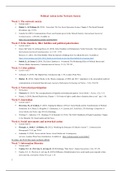Samenvatting
Summary Political Action in the Network society (readings lectures)
Notes for the exam (which I passed with 9.4) of every lectures (no week 4) and very in-depth notes of ALL THE READINGS and relevant things said in the seminars. It contains also a small practice exam that I made for myself with 1 or 2 questions per week.
[Meer zien]







